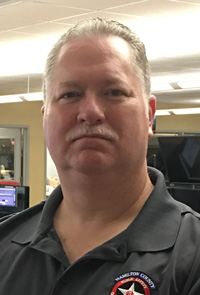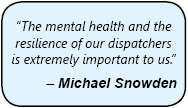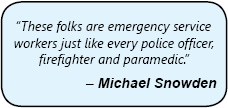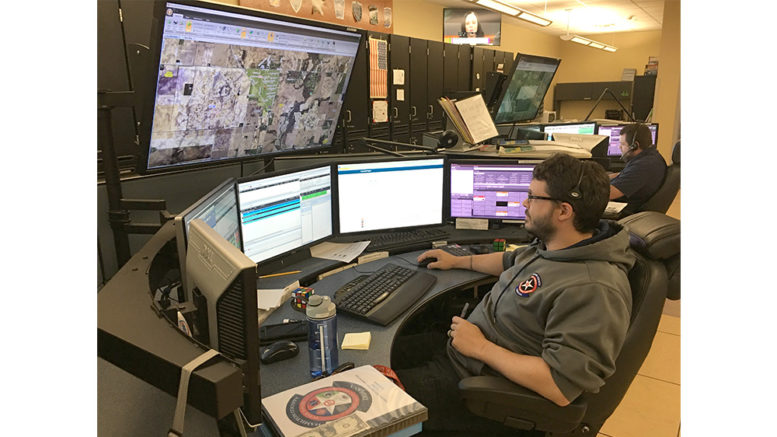Between 9 a.m. on Friday, May 25 – just before the first call came in about the active shooter at Noblesville West Middle School – until 5 p.m. that afternoon, Hamilton County 911 dispatchers handled 364 calls, of which the incident that has become a national news story was only one.

Snowden
“While that incident was occurring, life in the rest of Hamilton County was still occurring as well,” Hamilton County Public Safety Communications Executive Director Michael Snowden told The Reporter. “We had two completed suicides, one attempted suicide, 27 traffic accidents, 18 suspicious circumstances, 11 traffic hazards, eight thefts – we were busy literally all day long. It is hard to say we were no longer busy because of the school incident at ‘X’ time, but we were really busy that entire day.”
Snowden had three employees call within minutes of the shooting to ask if they needed to come in to the dispatch center to help. He accepted the offer from those first three off-duty volunteers. As other calls came in with similar offers, he had to decline.
“We had so many people in our room at that point between the people who were working, the administrative staff that came in and those off-duty folks, we had six or seven who called in that we turned away,” Snowden said. “We even had two people who no longer work for us who called and asked if we needed them to come in and help.”
The May 25 incident was only the second time since Snowden has been in charge of the dispatch center that they needed to work at full capacity. The room holds a total of 18 stations and there are some additional training stations available in an adjacent room.
When asked how his staff performed that day, the two words he used were “outstanding” and “stupendous.”
“I’ve been in this business 32 years,” Snowden said. “You never know how a person – or a group of people – is going to react to a bad situation until it happens. You can hope, plan and train, but you just don’t know. When that bad day happened to us, our staff performed very well. You could see the teamwork and the camaraderie in the room. We had people outside of our staff who walked into the room to see if we needed any help and every one of them remarked to me how calm it was in the room. That is a testament to the professionalism and the training of our folks.”
Training and preparation
That level of calm in the midst of a storm of chaos does not happen without a great deal of training and preparation. Hamilton County 911 dispatchers work 12-hour shifts and a portion of nearly every shift is spent on continued training and education. In the dispatch center they say, “Every day is a training day.”
“We do something nearly every day to account for training and it showed,” Snowden told The Reporter. “It absolutely showed that day and I am so proud of them.”
Local 911 dispatchers have had several active assailant trainings that are general. The “30,000-foot view” curriculum is meant to be nation-wide.
“We have had that training for quite a while now,” Snowden explained. “Then we get into Hamilton County specific training. Our staff has been invited to attend SWAT training at schools for a while now. We have had various members of our staff at schools observing and helping with that specific Hamilton County Training. Most recently a Fishers Police lieutenant and a Fishers firefighter put together a training for our staff that was extremely Hamilton County-centric.”
 That Fishers-sponsored local training was delivered to 911 staff the day before and three days before the May 25 incident.
That Fishers-sponsored local training was delivered to 911 staff the day before and three days before the May 25 incident.
“About half our staff were trained on Tuesday and the rest on Thursday,” Snowden said. “The people that were working Friday morning had been trained on that newest information Thursday afternoon.”
When asked if the school shooting will change anything about how Hamilton County 911 operates moving forward, Snowden said it has to.
“We had an operational debriefing [Thursday, May 31] with our staff who were on duty Friday and the folks who came in to help,” Snowden said. “We got together yesterday and just talked about it from a departmental standpoint – from the perspective of what we can actually control, change and make better. We are constantly improving all our processes. This was another process that we need to learn from and improve.”
Mental health of 911 dispatchers
One of the things that has come to the forefront for public safety is mental health of first responders: Police officers, firefighters and paramedics. But is more recent that such a focus has been given to the dispatchers who first deal emergencies every day of their professional lives.
“People understand the mental health issues that can occur for our first responders,” Snowden said. “We have come a long way for recognizing that for dispatchers as well, but not publicly. Within our profession we have learned that mental health is an issue for dispatchers as well.”
Last year Hamilton County brought in an expert from out of state to help teach local dispatchers resilience and self-care.
“It may not be one call that bothers you,” Snowden told The Reporter. “It may be after 5, 10 or 27 years of calls that the cumulative effect of the things that we deal with can really weigh on a person’s mind. Not every person and not on a cycle that you can say, but that does take its toll. We have really been looking at the resilience and mental health of our dispatchers for almost two years now.”
 Critical Incident Stress Management (CISM) debriefers were in the building the afternoon of the shooting. They were able to talk with all but two dispatchers who were working that day.
Critical Incident Stress Management (CISM) debriefers were in the building the afternoon of the shooting. They were able to talk with all but two dispatchers who were working that day.
“Before they even left, they sat down with the CISM debriefers,” Snowden said. “I was not privy to it, but they were able to just talk about whatever. The two who were not able to talk on Friday did talk to the debriefers on Saturday morning. They came back again Sunday and Thursday. They are peers. This is a police sergeant, a couple police officers and a psychologist who, of their own free will, stopped by to check on our folks and make sure they are OK. We are doing everything we can to ensure that our staff can process what happened that Friday.”
Mental health resources for local dispatchers doesn’t stop there. Cumulative effects of stress can show up at any time, and Snowden’s staff will have help whenever they need.
“It may be six months before someone says, ‘I’m really down and I think it was that call back in May that really triggered this,’” Snowden explained. “We will have the ability to refer them to someone or have those debriefers come back then because the mental health and the resilience of our dispatchers is extremely important to us.”
Unfortunately, for a long time, that level of support did not exist for dispatchers, in part because of the way they are classified by the U.S. Department of Labor (DOL).
911 dispatcher classification
 “The federal government still classifies emergency dispatchers as secretaries in the DOL,” Snowden said. “We have been fighting that for years. They are emergency personnel. When that first call arrived here there were no first responders on that scene. Very quickly there were, but when that first call came in, we were the first first responders.”
“The federal government still classifies emergency dispatchers as secretaries in the DOL,” Snowden said. “We have been fighting that for years. They are emergency personnel. When that first call arrived here there were no first responders on that scene. Very quickly there were, but when that first call came in, we were the first first responders.”
It doesn’t have to be a school shooting. For any medical, fire or law enforcement event your 911 dispatchers are immediately on the scene mentally, if not physically.
“The instant 911 is answered we are on that scene giving life-saving instructions, giving safety instructions or whatever is needed,” Snowden said. “To say ‘these are just like secretaries picking up the phone and sending police officers to the scene’ – that’s not the case. It is so technical and precise now that it is just a whole different world. We are trying to get the rest of the world to catch up to what these dispatchers do every day.”
 The DOL does a study of every classification every 10 years. They recently did that study and 911 dispatchers came as close as they ever have to getting reclassified, but in the end the DOL decided to maintain the current secretarial classification instead of changing it to emergency services. There are implications regarding pay scale, pension, health insurance and other factors that would be impacted by a change in classification.
The DOL does a study of every classification every 10 years. They recently did that study and 911 dispatchers came as close as they ever have to getting reclassified, but in the end the DOL decided to maintain the current secretarial classification instead of changing it to emergency services. There are implications regarding pay scale, pension, health insurance and other factors that would be impacted by a change in classification.
“I understand their reluctance, but I completely disagree with it,” Snowden told The Reporter. “These folks are emergency service workers just like every police officer, firefighter and paramedic.”

